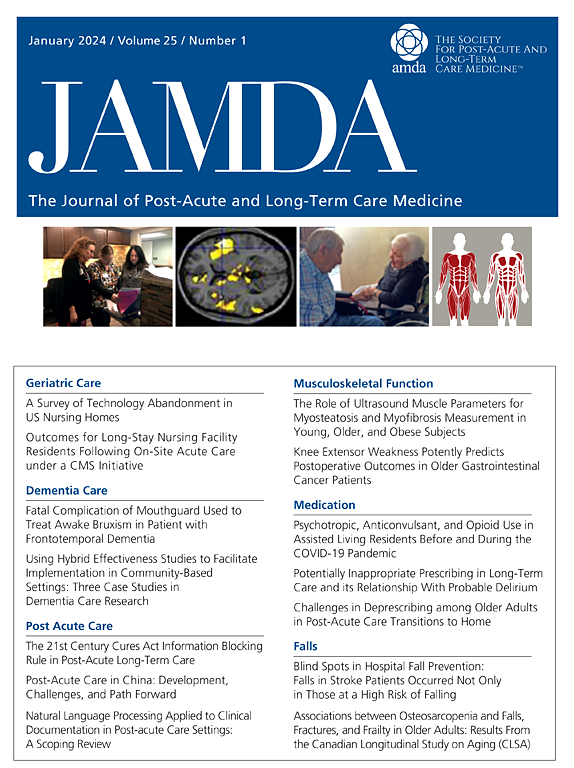利用电子病历检测患有痴呆症的养老院住户的躁动行为。
IF 3.8
2区 医学
Q2 GERIATRICS & GERONTOLOGY
Journal of the American Medical Directors Association
Pub Date : 2024-09-27
DOI:10.1016/j.jamda.2024.105289
引用次数: 0
摘要
目的:躁动行为(行为)在患有阿尔茨海默病和相关痴呆症(ADRD)的疗养院(NH)住户中很常见。行为管理干预的务实试验依赖于常规收集的最小数据集(MDS)数据来评估研究结果,尽管已知存在报告不足的情况。我们介绍了一种利用NH电子病历(EMR)中的结构化和非结构化数据来增强基于MDS的行为测量方法:设计:对一家多州 NH 公司的 EMR 数据进行重复横截面分析:从 2020 年 1 月到 2022 年 8 月,患有 ADRD 的长期住院患者(在 NH 至少住院 90 天):对研究期间患有 ADRD 的 NH 居民进行季度和年度评估。在 MDS 中,任何行为都被定义为 "激动和反应行为量表 "中的 1 分或更高分。对于结构化的 EMR 数据,任何行为的定义是住院患者在 "减少急性护理转院、病情变化干预"(INTERACT)表格上的躁动、言语攻击或身体攻击行为增加。对于非结构化的 EMR 数据,任何行为都是通过自由文本订单的关键字搜索来定义的:共确定了 322 家 NHs 中 19,705 名患有 ADRD 的长期住院患者的 77,936 项 MDS 评估;仅使用 MDS,每月有行为的住院患者占 14.8%(SD 35.6);使用 MDS 和 INTERACT,每月有行为的住院患者占 16.2%(SD 36.9);使用 MDS、INTERACT 和医嘱,每月有行为的住院患者占 18.6%(SD 38.9)。使用 EMR 数据对 MDS 进行补充后,行为识别率提高了 3.8 个百分点(相对提高 25.7%)。只有不到 0.5%的患者在研究月中的所有 3 个数据源中都有行为记录:结论与启示:与仅使用 MDS 相比,使用 EMR 数据可增加可检测到的行为。这三种数据源捕获了不同类型的行为,将它们结合使用可能是一种更全面的识别策略。这些结果对于更有针对性地采取干预措施和分配资源以改善有 ADRD 相关行为的 NH 居民的生活质量非常重要。本文章由计算机程序翻译,如有差异,请以英文原文为准。
Detecting Agitated Behaviors in Nursing Home Residents With Dementia Using Electronic Medical Records
Objectives
Agitated behaviors (behaviors) are common in nursing home (NH) residents with Alzheimer's disease and related dementias (ADRD). Pragmatic trials of behavior management interventions rely on routinely collected Minimum Data Set (MDS) data to evaluate study outcomes, despite known underreporting. We describe a method to augment MDS-based behavioral measures with structured and unstructured data from NH electronic medical records (EMR).
Design
Repeated cross-sectional analyses of EMR data from a single multistate NH corporation.
Setting and Participants
Long-stay residents (at least 90 days in NH) with ADRD from January 2020 through August 2022.
Methods
Quarterly and annual assessments of NH residents with ADRD during the study period were identified. For MDS, any behavior was defined as a score of 1 or higher on the Agitated and Reactive Behavior Scale. For structured EMR data, any behavior was defined as increased resident agitation, verbal aggression, or physical aggression on the Interventions to Reduce Acute Care Transfers, Change in Condition form (INTERACT). For unstructured EMR data, any behavior was defined using keyword searches of free-text orders.
Results
A total of 77,936 MDS assessments for 19,705 long-stay residents with ADRD in 322 NHs were identified; 14.8% (SD 35.6) of residents had behaviors per month using MDS alone, 16.2% (SD 36.9) using MDS and INTERACT, and 18.6% (SD 38.9) using MDS, INTERACT, and orders. Supplementing MDS with EMR data increased behavior identification by 3.8 percentage points (a 25.7% relative increase). Less than 0.5% had behaviors noted in all 3 sources consistently across study months.
Conclusions and Implications
Using EMR data increased detectable behaviors vs the MDS alone. The 3 sources captured different types of behaviors and using them together may be a more comprehensive identification strategy. These results are important for better targeting of interventions and allocation of resources to improve the quality of life for NH residents with ADRD-related behaviors.
求助全文
通过发布文献求助,成功后即可免费获取论文全文。
去求助
来源期刊
CiteScore
11.10
自引率
6.60%
发文量
472
审稿时长
44 days
期刊介绍:
JAMDA, the official journal of AMDA - The Society for Post-Acute and Long-Term Care Medicine, is a leading peer-reviewed publication that offers practical information and research geared towards healthcare professionals in the post-acute and long-term care fields. It is also a valuable resource for policy-makers, organizational leaders, educators, and advocates.
The journal provides essential information for various healthcare professionals such as medical directors, attending physicians, nurses, consultant pharmacists, geriatric psychiatrists, nurse practitioners, physician assistants, physical and occupational therapists, social workers, and others involved in providing, overseeing, and promoting quality

 求助内容:
求助内容: 应助结果提醒方式:
应助结果提醒方式:


